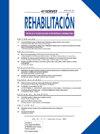应用EWGSOP2的F-A-C-S通路诊断慢性阻塞性肺疾病患者肌肉减少症的挑战:一项诊断准确性研究
Q3 Medicine
引用次数: 0
摘要
主要目的是根据欧洲老年人肌肉减少症工作组(EWGSOP2)的F-A-C-S(查找病例-评估-确认-严重程度)算法,评估在肺康复环境中使用的SARC-F问卷和肌肉功能测试的性能。方法对慢性阻塞性肺疾病(COPD)患者进行肺康复诊断准确性研究。结果205例患者(66.8岁;74.1%男性),29例(14.1%)符合EWGSOP2的肌少症诊断标准。SARC-F的敏感性为13%,特异性为92.8%。计算出诊断准确度最高的截断点,男性握力为30.3 kg,女性四头肌最大自主等距收缩(Q-MVIC)为17.3 kg。结论SARC-F问卷作为筛查工具的诊断准确性较低,并且它不能识别COPD康复患者的肌肉减少症,这表明该人群可以从直接方法(a - c - s)中获益。握力测定在男性中提供了最好的诊断准确性,截断点为30.3 kg,在女性中,Q-MVIC测定在肌肉减少症诊断中表现出更好的性能,截断点为17.3 kg。本文章由计算机程序翻译,如有差异,请以英文原文为准。
The challenge of applying the F-A-C-S pathway from EWGSOP2 for sarcopenia diagnosis in patients with chronic obstructive pulmonary disease: A diagnostic accuracy study
Objective
The main objective was to evaluate the performance of the SARC-F questionnaire and muscle function tests used in pulmonary rehabilitation settings following the F-A-C-S (Find cases-Assess-Confirm-Severity) algorithm of the European Working Group on Sarcopenia in Older People (EWGSOP2).
Methods
Diagnostic accuracy study in consecutive patients with chronic obstructive pulmonary disease (COPD) referred to pulmonary rehabilitation.
Results
Of 205 patients (66.8 years; 74.1% men), 29 (14.1%) met the diagnostic criteria for sarcopenia according to EWGSOP2. The sensitivity and specificity of SARC-F were 13% and 92.8%, respectively. Cutoff points with the highest diagnostic accuracy were calculated, with handgrip at 30.3 kg in men and quadriceps maximal voluntary isometric contraction (Q-MVIC) at 17.3 kg in women.
Conclusions
The diagnostic accuracy of the SARC-F questionnaire as a screening tool is low and it did not identify sarcopenia in rehabilitation patients with COPD, suggesting that this population could benefit from a direct approach (A-C-S). Handgrip strength determination provided the best diagnostic accuracy in men, with a cutoff point of 30.3 kg, and in women, Q-MVIC determination showed better performance for sarcopenia diagnosis, with a cutoff point of 17.3 kg.
求助全文
通过发布文献求助,成功后即可免费获取论文全文。
去求助
来源期刊

Rehabilitacion
Medicine-Rehabilitation
CiteScore
0.80
自引率
0.00%
发文量
63
期刊介绍:
La revista que es desde hace más de 40 años la publicación oficial de la Sociedad Española de Rehabilitación y referente de la mayoría de las Sociedades de la Especialidad de los países americanos de habla hispana. Se publican 5 números pluritemáticos al año y uno monográfico sobre un tema del mayor interés y actualidad designado por el consejo de redacción.
 求助内容:
求助内容: 应助结果提醒方式:
应助结果提醒方式:


